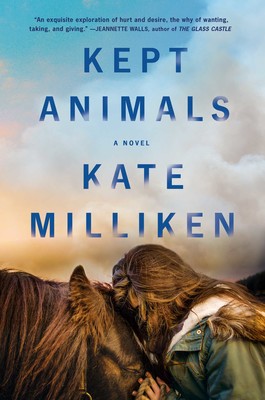Kept Animals by Kate Milliken. Scribner, 2020. $27.00, 368 pages.
It’s been three months since I’ve found the time to read a whole novel, and part of me was wondering whether I’d forgotten how to read completely until I opened up Kate Milliken’s Kept Animals. Told through a mix of character perspectives, the novel jumps back and forth from 1993 to 2015, revealing the story of Rory Ramos, a fifteen-year-old girl navigating her identity in Topanga Canyon, California. Complicated explorations of family dynamics, sexuality, race, and patriarchal norms weave through each character, making this book as heart wrenching as it is memorable.
We are introduced to Rory with some basic knowledge of her interests: horses and photography. She works at a horse stable with her stepfather Gus, and the stable is frequented by others her own age, including the wealthy twins June and Wade Fisk. She is less wealthy than other characters, and doesn’t own a car like many of her peers. She has to catch a ride home with June one afternoon after completing her stable duties. It’s obvious this is one of their first real interactions; Rory invites June inside, she smokes her first joint, and has a first “kiss”: “‘Now exhale,’ June said, her mouth already on Rory’s mouth as she spoke. Not a kiss. Rory recognized this was not a kiss. June was inhaling, pulling the smoke up out of Rory’s lungs and into her own.”
It is complicated and awkward and everything I need in a book. I was enjoying it all up to this point, but this is where I became fully immersed in the text: it felt like I easily could have been Rory in this moment.
The elusive Vivian Price, whose pool is visible from Rory’s bedroom, is spotted by the other girls. Vivian is the daughter of absent parents Sarah and Everett Price; it becomes clear quickly just how much independence Vivian actually has, and it molds her into someone that, despite her inherently selfish demeanor, is empathetic in her struggles. We experience life through her point of view multiple times; she is lonely and desperate for attention in her life, and she takes it in the form of former teacher McLeod, Wade Fisk, and, after a tragic accident involving her toddler brother and Gus, Rory. Each relationship reveals a facet of Vivian’s personality, but they all ultimately show her desire for power, as she uses these people to feel in- control of her out-of-control life. Vivian’s ties with the three of them converge as the plot moves. While Charlie’s death is the tipping point of the story’s conflict, it is the actions taken afterwards that push the novel’s most complicated issues forward, and it is driven by these characters, rather than by plot. It’s one of the best things about this book, actually: Milliken weaves every bit of social and political drama together, creating something subtle and cohesive. Picking apart those links between characters, disputes, and settings is what kept this novel on my mind, even days after finishing it.
The jumps between 1993 and 2015 are just as compelling as the story’s several conflicts, too. Though much of the plot is driven through Rory’s perspective, she’s not a particularly emotional narrator. Vivan wears her heart on her sleeve and is easy to read because of the way her dialogue moves in interactions with her parents and love interests: “…more than anything she liked the way it felt when Rory photographed her afterward. She felt briefly powerful then, cunning, like she had everything going for her.” Rory is almost a polar opposite. She’s uncomfortable exploring her sexuality, deals with issues of consent with June, and is drawn to Vivian in ways that she seems unable to convey in words, so she turns to photography. We ultimately have to rely on Milliken’s description of Rory’s photos to scratch the surface of her thoughts, personality, and motivations, which was such a unique component of the author’s writing.
We never see Rory in 2015, as her career as a photojournalist abroad in war-torn countries keeps her away from home and her family, so what we know of her in her adult years comes from her daughter. Learning about this “new,” adult Rory through an otherwise foreign perspective further encapsulates just how intricate her depth is, and discovering Rory at the same pace as her daughter creates a significant, immersive setting that I found impossible to tear myself away from. I’ll be returning to this novel again and again, and I’m certain that in my future reads, I’ll discover even more of each character. That’s really what pushes a book from good to great–and Kept Animals is decidedly in the “fantastic” category.
Britton Hansen is a recent graduate from Loyola University New Orleans. She is a writer and political organizer from Albuquerque, New Mexico. She plans to pursue an MFA as soon as the country is put back on track in 2020.

